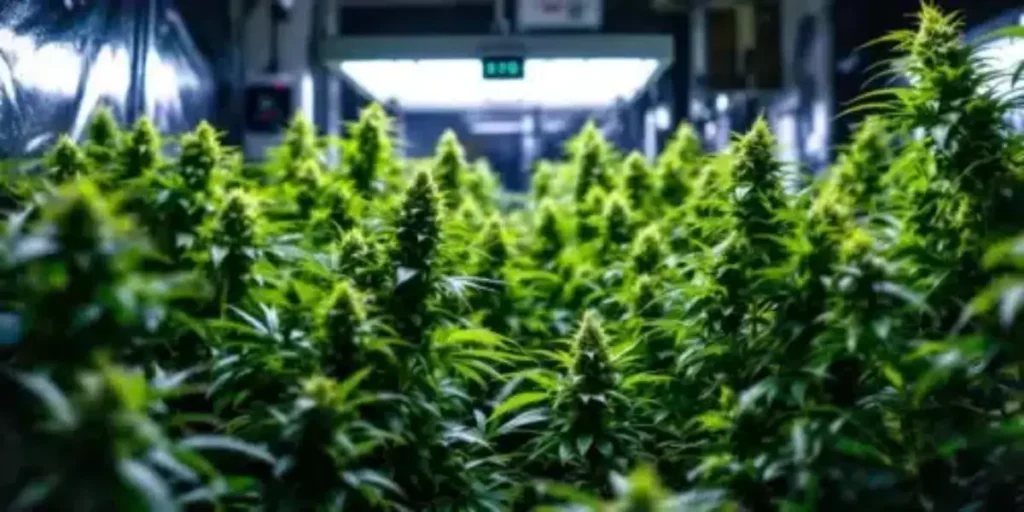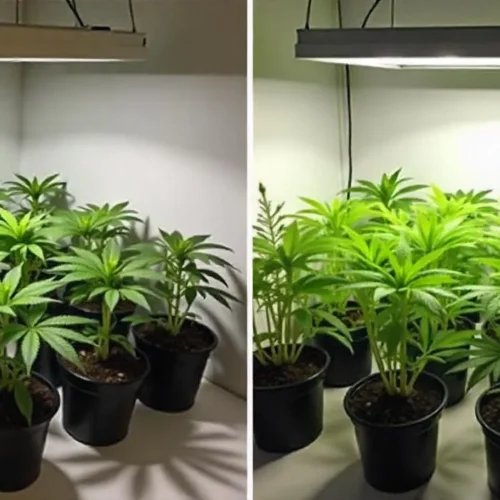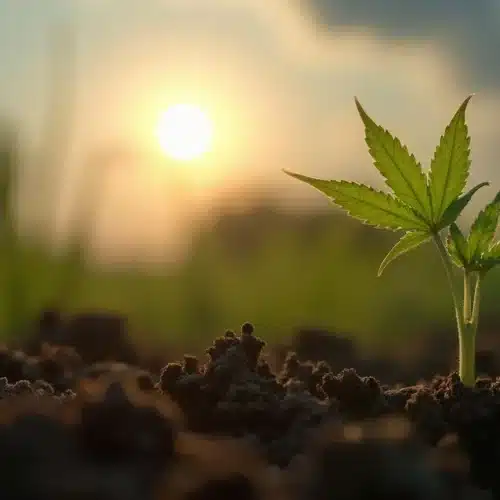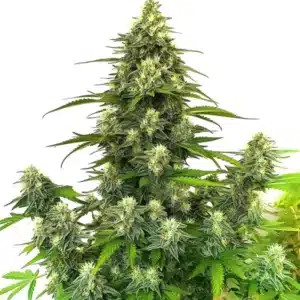Autoflowering cannabis strains are often praised for their ease and speed. But before you dive into this method, it’s essential to understand the cons of autoflowering cannabis. These plants, though convenient, come with challenges that can significantly impact your yield, quality, and overall growing experience.
Uncovering the Limitations of Autoflowering Cannabis
Autoflowering strains promise faster harvests and less dependency on light schedules. However, these benefits come with limitations that could be deal-breakers depending on your goals.
Recommended Strains
Fat Bastard Auto HMC Edition
 THC: 30% - 38%
THC: 30% - 38% Type of seed: Autoflowering
Type of seed: Autoflowering Phenotype: Mostly Hybrid
Phenotype: Mostly Hybrid Day to flower: 8 - 10 weeks
Day to flower: 8 - 10 weeks
Fat Bastard HMC Edition
 THC: 30% - 38%
THC: 30% - 38% Type of seed: Feminized
Type of seed: Feminized Phenotype: Mostly Hybrid
Phenotype: Mostly Hybrid Day to flower: 8 - 10 weeks
Day to flower: 8 - 10 weeks
Reduced Yield Compared to Photoperiod Strains
One of the biggest cons of autoflowering cannabis strains is their reduced yield. Autoflowers are programmed to grow and flower within a set timeframe, regardless of environmental conditions. This fixed lifecycle means the plant has less time to develop a robust root system, which directly impacts its size and yield.
For growers focused on maximizing their harvest, this can be a major drawback. Photoperiod strains allow for an extended vegetative stage. During this stage, the plant can grow larger before flowering. This results in higher yields, which can make a big difference if you’re growing cannabis for commercial purposes or personal use.
Limited Training Opportunities
Another notable limitation is the reduced opportunity for plant training. Techniques like topping, low-stress training (LST), or scrogging are popular among growers. These methods maximize light exposure and increase yield. However, these techniques require time something that autoflowering plants don’t afford you.
Autoflowering strains move quickly from the vegetative stage to flowering. This leaves little time to manipulate the plant’s structure effectively. Any attempt to train the plant can result in stunted growth or reduced yield if not timed perfectly. For those who enjoy plant training and its benefits, this is a serious con of autoflowering.
The Fixed Growth Cycle: A Double-Edged Sword
The fixed growth cycle of autoflowering strains is both a blessing and a curse. It simplifies the growing process by eliminating the need to adjust light schedules to trigger flowering. However, this characteristic limits your control over the plant’s development.
If your plant encounters issues such as nutrient deficiencies, pest infestations, or environmental stress during its brief vegetative stage, there’s little time to correct these problems before the plant transitions to flowering. Once the flowering stage begins, the plant’s energy focuses on producing buds. This leaves less room for recovery or further growth. This lack of flexibility can be a significant con of autoflowering for growers who need more control over their grow cycles.
Lower THC Content in Some Strains
Another key con of autoflowering strains is the potential for lower THC content. While breeding advancements have improved the potency of many autoflowers, they still generally lag behind photoperiod strains in terms of THC levels. This is due to the influence of Cannabis ruderalis, the species from which autoflowers derive their unique traits. Ruderalis plants are naturally lower in THC. Even with hybridization, some of this genetic predisposition remains.
For growers who prioritize high potency in their cannabis, this can be a dealbreaker. Although there are high-THC autoflowering strains available, they often come with trade-offs in yield or growth time. If your primary goal is to produce the most potent cannabis possible, the lower THC potential is a significant con of autoflowering strains.
Smaller Plant Size: Convenient but Limiting
The compact size of autoflowering plants can be both an advantage and a disadvantage. On the positive side, their smaller stature makes them ideal for growers with limited space. They can easily be cultivated in small grow tents, closets, or even outdoor areas where discretion is necessary.
However, this smaller size also means smaller yields. The limited vegetative growth period results in plants that don’t reach the same height or girth as photoperiod strains. This directly impacts the amount of bud they can produce. For commercial growers or those looking to maximize their harvest, this is another significant con of autoflowering cannabis.
Sensitivity to Environmental Stress
Autoflowering strains are often marketed as easy-to-grow and resilient. But their fixed lifecycle makes them more sensitive to environmental stress. Issues like temperature fluctuations, humidity changes, or nutrient imbalances can have a more profound effect on autoflowers. They don’t have the luxury of time to recover.
With photoperiod strains, if a plant experiences stress, the grower can extend the vegetative period. This gives the plant time to bounce back before initiating flowering. Autoflowers don’t have this option. Once they start flowering, they’re on a set path to maturity, regardless of their health or condition. This sensitivity to stress is a critical con of autoflowering strains that can catch new growers off guard.
Promos & Deals
Genetic and Cloning Challenges in Autoflowering Strains
The genetic makeup of autoflowering cannabis presents unique challenges that can impact both the cultivation process and the end product. Knowing these challenges is essential for anyone considering autoflowers.

Limited Genetic Diversity
One of the major cons of autoflowering strains is the limited genetic diversity available. Since autoflowers are bred from a smaller gene pool largely due to their ruderalis heritage there’s less variation in traits such as potency, flavor, and resistance to pests or diseases. This can limit your ability to find a strain that perfectly matches your needs.
In contrast, photoperiod strains benefit from a broader genetic base, offering a wider selection of traits and characteristics. This diversity allows growers to select strains specifically suited to their growing conditions or desired effects. The limited genetic diversity in autoflowers means fewer choices and potentially less satisfaction with the end result.
Difficulty in Cloning Autoflowering Plants
Cloning is a popular technique among cannabis growers because it allows for the replication of plants with desirable traits. However, cloning autoflowering strains is notoriously difficult, if not impossible, to achieve successfully. The issue lies in the plant’s fixed lifecycle. Since autoflowers transition from vegetative growth to flowering based on age rather than light exposure, clones inherit the same biological age as the mother plant. This means they will flower at the same time as the original plant, regardless of their size or developmental stage.
For growers who rely on cloning to preserve genetics, this is a significant con of autoflowering strains. Without the ability to clone, growers must continually purchase new seeds, adding to the cost and unpredictability of their grow operation.
Less Breeding Potential
Breeding your cannabis strains is a rewarding process that allows for the development of unique hybrids with specific traits. However, the fixed lifecycle of autoflowering plants makes breeding a challenge. Timing is crucial when breeding autoflowers, and any misstep can result in lost opportunities for successful pollination.
Furthermore, the reliance on ruderalis genetics can make it difficult to breed autoflowering strains with the same level of potency or complexity as photoperiod strains. While there have been advancements in autoflower breeding, the inherent limitations of the gene pool remain a significant con of autoflowering cannabis.
Lower Customization for Specific Traits
The genetic limitations of autoflowering strains also impact the ability to customize plants for specific traits. Whether you’re looking for high CBD content, particular terpene profiles, or resistance to specific environmental factors, your options with autoflowers are more limited compared to photoperiod strains.
This lack of customization can be a serious con of autoflowering for growers with specific needs or preferences. While photoperiod strains offer a wide range of choices, autoflowers often fall short in this area, making it harder to find the perfect strain for your grow.
Cost and Economic Considerations
When evaluating the cons of autoflowering cannabis, the economic impact is a critical factor. While these strains may seem cost-effective due to their shorter growth cycle and lower maintenance requirements, hidden costs can add up quickly.

Higher Seed Costs
One of the first economic drawbacks of autoflowering strains is the cost of seeds. Autoflowering seeds tend to be more expensive than photoperiod seeds due to the specialized breeding required to produce them. This higher upfront cost can be a deterrent for budget-conscious growers or those looking to maximize their investment.
For commercial growers, the repeated need to purchase seeds for each new crop can significantly increase operating costs. Unlike photoperiod strains, where cloning can reduce the need for new seeds, autoflowering strains require fresh seeds each time, adding to the overall expense.
Increased Costs for Multiple Harvests
While the ability to achieve multiple harvests in a single growing season is a selling point for autoflowers, it comes with additional costs. Each new crop requires new seeds, nutrients, and other growing supplies. Over time, these recurring expenses can add up, potentially negating the benefits of faster harvest cycles.
This is particularly relevant for commercial growers, who must carefully calculate the cost-benefit ratio of autoflowering strains. While quick turnover can be advantageous, the increased operational costs may offset the financial gains, making this a significant con of autoflowering cannabis.
Shorter Lifespan Leading to Frequent Replacements
The shorter lifespan of autoflowering plants means that growers must continually start new crops to maintain production. This frequent turnover requires more labor, more resources, and more time, all of which contribute to higher costs.
For those who are growing on a larger scale, the need for constant replanting and care can quickly become a logistical challenge. This is a critical con of autoflowering strains that can impact both small-scale and commercial operations.
Quality and Potency Concerns
The quality and potency of your cannabis harvest are often the most critical factors for any grower. Autoflowering strains, while convenient, can sometimes fall short in these key areas.
Potential for Lower Potency
One of the most significant cons of autoflowering strains is the potential for lower potency. While breeders have made strides in improving the THC levels of autoflowers, they still generally produce less potent cannabis compared to photoperiod strains. This is primarily due to the ruderalis genetics that are part of the autoflowering gene pool, which naturally has lower THC levels.
For recreational users or medical patients who require high-potency cannabis, this can be a major drawback. The lower THC content means that the effects of the cannabis may not be as strong or as long-lasting, potentially leading to dissatisfaction with the final product.
Variation in Cannabinoid Content
Another quality concern with autoflowering strains is the variability in cannabinoid content. Due to the complex breeding process and the influence of ruderalis genetics, autoflowers can exhibit significant variation in their cannabinoid profiles, even within the same strain.
This inconsistency can be problematic, especially for medical users who rely on specific cannabinoid ratios for their treatment. The unpredictable nature of autoflowering strains makes it difficult to achieve consistent results, which is a significant con of autoflowering cannabis for those who need reliable potency and effects.
Less Complex Flavor Profiles
The flavor and aroma of cannabis are determined by its terpene profile, which can be less complex in autoflowering strains. While some autoflowers have been bred to enhance their terpene content, many still lack the rich, layered flavors found in photoperiod strains.
For cannabis connoisseurs who value the sensory experience as much as the effects, this is a notable con of autoflowering strains. The simpler flavor profiles may not satisfy those who seek the full, nuanced flavors that are characteristic of high-quality photoperiod cannabis.
Cultivation Constraints and Challenges
Growing cannabis, whether autoflowering or photoperiod, requires careful attention to detail. However, autoflowering strains present unique challenges that can constrain your cultivation efforts. Realizing these limitations is crucial for anyone considering these types of plants.
Inflexibility with Light Schedules
One of the key advantages of autoflowering strains is their ability to flower under any light schedule, which simplifies the growing process. However, this feature can also be a significant con of autoflowering strains due to the inflexibility it introduces.
Photoperiod strains allow growers to control when the plant enters the flowering stage by adjusting the light schedule. This flexibility is particularly useful if you need to extend the vegetative phase to correct issues or promote more growth. In contrast, autoflowers begin flowering based on their age, not the light cycle. This lack of control can be frustrating, especially if your plants encounter problems early on. Without the option to delay flowering, you’re left with little choice but to accept whatever the plant produces, which can be disappointing if the plant was stressed or underdeveloped.
Less Tolerance for Nutrient Errors
Autoflowering strains grow quickly, which means they also react quickly to their environment both positively and negatively. This rapid growth can be advantageous, but it also means that autoflowers are less forgiving when it comes to nutrient management.
Because these plants progress through their life cycle so quickly, any nutrient imbalances can have a more immediate and severe impact. Over-fertilizing or underfeeding can lead to stunted growth, reduced yields, or even plant death, and there’s less time to correct these mistakes compared to photoperiod strains. This lack of tolerance for nutrient errors is a significant con of autoflowering cannabis, particularly for novice growers who might not yet have perfected their feeding regimens.
Limited Recovery Time from Stress
Another cultivation challenge with autoflowering strains is their limited ability to recover from stress. Whether the stress is caused by environmental factors like temperature fluctuations or physical damage from pests, autoflowers have a fixed timeframe in which to recover before they start flowering.
Photoperiod plants can be kept in the vegetative stage longer if they need time to recover, allowing the plant to heal and regain strength before flowering. Autoflowers, on the other hand, don’t offer this flexibility. Once they hit a certain age, they will start flowering regardless of their condition. This can result in smaller plants with lower yields, making the recovery time or lack thereof a critical con of autoflowering cannabis.
Market and Consumer Perception
The perception of autoflowering cannabis strains in the market can significantly impact their success, especially for commercial growers. Knowing how these strains are viewed by consumers and the challenges they present in meeting market demands is crucial.

Perception of Lower Quality
Despite the advancements in autoflowering genetics, there remains a widespread perception that autoflowers are of lower quality compared to photoperiod strains. This stigma is largely rooted in the early days of autoflowering strains, which were often less potent and flavorful than their photoperiod counterparts.
Even though modern autoflowering strains have improved, this perception persists among many consumers, particularly those who consider themselves cannabis connoisseurs. For commercial growers, this can be a significant hurdle. If the market views autoflowers as inferior, it may be challenging to sell your product at a competitive price, even if the quality has improved. Overcoming this perception requires educating consumers about the benefits of modern autoflowering strains and highlighting any breeding advancements that have enhanced their potency, flavor, and overall quality.
Limited Appeal to Experienced Growers
Experienced cannabis growers often prefer photoperiod strains because of the control and customization they offer. The ability to manipulate the light cycle, employ advanced training techniques, and extend the vegetative stage gives photoperiod plants a level of flexibility that autoflowers lack.
For seasoned cultivators, the limitations of autoflowering strains such as their fixed growth cycle and reduced training opportunities can make them less appealing. These growers may view autoflowers as suitable only for beginners or those with specific constraints, rather than as a serious option for high-quality cannabis cultivation. This limited appeal is a significant con of autoflowering strains, particularly for those who prioritize control and the ability to fine-tune their growing environment.
Challenges in Meeting Market Demands
The variability in quality and consistency of autoflowering strains can also pose challenges in meeting market demands. Consumers are increasingly discerning, with many seeking specific cannabinoid profiles, terpene content, and overall quality in their cannabis products. The inherent variability in autoflowering strains, combined with their sometimes lower potency, can make it difficult to consistently produce a product that meets these high standards.
For commercial growers, this inconsistency can be a significant barrier to success. In a competitive market where consumers have numerous options, being able to guarantee a consistent, high-quality product is crucial. The unpredictability of autoflowering strains can make it harder to achieve this consistency, which is a critical con of autoflowering cannabis for those who are growing on a commercial scale.
Balancing the Pros and Cons of Autoflowering Strains
When deciding whether to grow autoflowering cannabis strains, it’s essential to weigh the pros and cons carefully. While we’ve discussed the significant cons of autoflowering cannabis, it’s important to also consider the benefits these strains can offer. By considering both perspectives, you’ll be able to make a more informed decision that suits your growing goals.
The Appeal of Autoflowering Strains Despite Their Drawbacks
Autoflowering strains have gained popularity for a reason. Their rapid growth cycle and ability to flower under any light schedule make them an attractive option for growers with limited time or space. These characteristics are particularly beneficial for those who are new to cannabis cultivation or for those who want a quicker turnaround from seed to harvest.
However, as we’ve explored, these advantages come with trade-offs. The reduced yield, limited training opportunities, and potential for lower potency are significant cons of autoflowering strains that can’t be ignored. For some growers, these drawbacks might outweigh the benefits, especially if they’re aiming for high yields or potent harvests.
Strategies to Mitigate the Cons of Autoflowering
If you decide that the benefits of autoflowering strains outweigh the drawbacks, there are strategies you can employ to mitigate some of the cons of autoflowering. For example, careful selection of strains with higher THC content can address potency concerns. Additionally, optimizing your growing environment to reduce stress and ensure proper nutrient management can help you achieve better results, despite the shorter growth cycle.
Choosing strains that have been specifically bred for higher yields or more complex flavor profiles can also help you overcome some of the limitations we’ve discussed. While autoflowers may never reach the same potential as photoperiod strains in certain areas, selecting the right genetics can make a significant difference.
Is Autoflowering Right for You?
Determining whether autoflowering marijuana strains are the right choice for your grow depends on your specific circumstances and goals. If you prioritize a low-maintenance grow with a faster harvest cycle, autoflowers might be the perfect fit. They offer the convenience of a simplified growing process and the ability to produce multiple harvests in a single season, which can be particularly advantageous for personal growers or those with limited space.
However, if your primary goal is to achieve the highest possible yields, maximize potency, or have complete control over the growing process, the cons of autoflowering strains may be too significant to overlook. Photoperiod strains offer more flexibility and potential for larger, more potent harvests, which might better suit your needs if these factors are your top priority.
For commercial growers, the decision is even more complex. While autoflowers can offer a quicker product turnover, the challenges of meeting market demands with consistent quality and potency can be significant. The perception of autoflowers as lower quality compared to photoperiod strains also plays a role in consumer preferences, potentially affecting your ability to market and sell your product.
Considerations for Commercial Growers
If you’re a commercial grower, the cons of autoflowering strains take on additional importance. In a competitive market, producing a consistent, high-quality product is crucial for maintaining customer loyalty and maximizing profits. Autoflowers, with their shorter growth cycle and potential for variability in cannabinoid content, can present challenges in achieving this consistency.
One strategy for commercial growers is to integrate autoflowering strains into a broader cultivation plan that includes both autoflowers and photoperiod strains. This approach allows you to benefit from the quick turnover of autoflowers while still producing the higher-yielding, more potent photoperiod strains that your customers may prefer. By diversifying your grow, you can mitigate some of the cons of autoflowering while taking advantage of their faster growth cycle.
Marketing and education also play a significant role in overcoming the perceived quality gap between autoflowering and photoperiod strains. As a grower, it’s essential to communicate the benefits of your autoflowering strains to consumers, emphasizing advancements in genetics that have improved potency, flavor, and overall quality. Educating your customers about these improvements can help shift perceptions and increase acceptance of autoflowers in the marketplace.
How Breeding Helps Overcome the Drawbacks of Autoflowering
Breeding advancements have played a crucial role in addressing some of the cons of autoflowering cannabis. Early autoflowering strains were often criticized for their lower potency and limited flavor profiles, but modern breeders have made significant strides in improving these characteristics.
By selectively breeding autoflowering plants with high-THC photoperiod strains, breeders have developed autoflowers that offer better potency and more complex terpene profiles. These advancements have made autoflowering strains a more viable option for those seeking a balance between convenience and quality.
However, breeding improvements can only go so far. The inherent limitations of the autoflowering lifecycle—such as the inability to extend the vegetative phase or the challenges of cloning—remain significant cons of autoflowering strains. These issues are among the most common autoflower problems that growers face. While breeders continue to push the boundaries of what autoflowers can achieve, it’s essential for growers to understand these limitations and set realistic expectations for their plants.
Practical Tips for Growing Autoflowering Cannabis
If you decide to grow autoflowering strains despite their limitations, there are several best practices you can follow to optimize your results. These tips can help you mitigate some of the cons of autoflowering and make the most of your grow.

Optimize Your Growing Environment
Given the rapid lifecycle of autoflowers, it’s crucial to create an optimal growing environment from the start. Ensure that your plants have consistent access to the right amount of light, nutrients, and water. Pay close attention to temperature and humidity levels, as fluctuations can stress your plants and impact their growth.
Using high-quality soil or hydroponic systems can also help provide the necessary nutrients for fast-growing autoflowers. Additionally, consider using supplements or boosters designed specifically for cannabis to enhance growth and flowering.
Start with High-Quality Seeds
Since you can’t clone autoflowers, it’s vital to start with the best seeds possible. Invest in seeds from reputable breeders who specialize in autoflowering strains. Look for strains that have been bred for higher yields, increased potency, and better flavor profiles. This initial investment can pay off in the long run by helping you achieve better results.
Be Mindful of Timing
Timing is everything when it comes to growing autoflowering cannabis. Since these plants have a fixed lifecycle, any delays or mistakes early on can have a significant impact on your final yield. Plant your seeds at the right time of year if growing outdoors, and be prepared to provide the ideal conditions as soon as they sprout.
Autoflowers don’t offer the luxury of extended vegetative growth, so be ready to support their rapid development from the beginning. This includes ensuring that they receive adequate light and nutrients during their short vegetative stage to maximize their potential before flowering begins.
Avoid Stressing Your Plants
Because autoflowers have limited recovery time, it’s essential to minimize stress throughout their growth. Avoid overwatering, overfeeding, or exposing your plants to extreme temperatures. Keep a close eye on your plants for signs of nutrient deficiencies, pests, or other issues, and address them promptly to prevent any negative impact on your yield.
Consider Light Cycles Carefully
While autoflowers can flower under any light schedule, many growers find that a consistent light cycle, such as 18/6 (18 hours of light, 6 hours of darkness), helps maximize growth and yield. Some growers even opt for 20/4 or 24/0 light cycles to further boost growth, although this can increase energy costs.
Experiment with different light cycles to see what works best for your specific strain and growing conditions. Just remember that once autoflowers start flowering, they will continue to do so regardless of the light cycle, so your main focus should be on maximizing vegetative growth before this transition.
FAQs
Why do autoflowering strains yield less than photoperiod strains?
Autoflowering strains yield less because they have a fixed life cycle and limited vegetative growth. Unlike photoperiod plants, they don’t allow extended veg stages to build large root systems and plant structures, which directly reduces overall yield.
Are autoflowering cannabis strains harder to clone?
Yes, cloning autoflowering cannabis strains is difficult and generally ineffective. Clones inherit the biological age of the mother plant, meaning they begin flowering regardless of size or development, making traditional cloning techniques unsuitable for autoflowers.
What are the biggest drawbacks of growing autoflowering cannabis?
The major cons of autoflowering cannabis include reduced yield, limited training time, lower THC potential in some strains, difficulty in cloning, and less control over the growing cycle. These limitations can impact quality, consistency, and customization for specific grow goals.


















